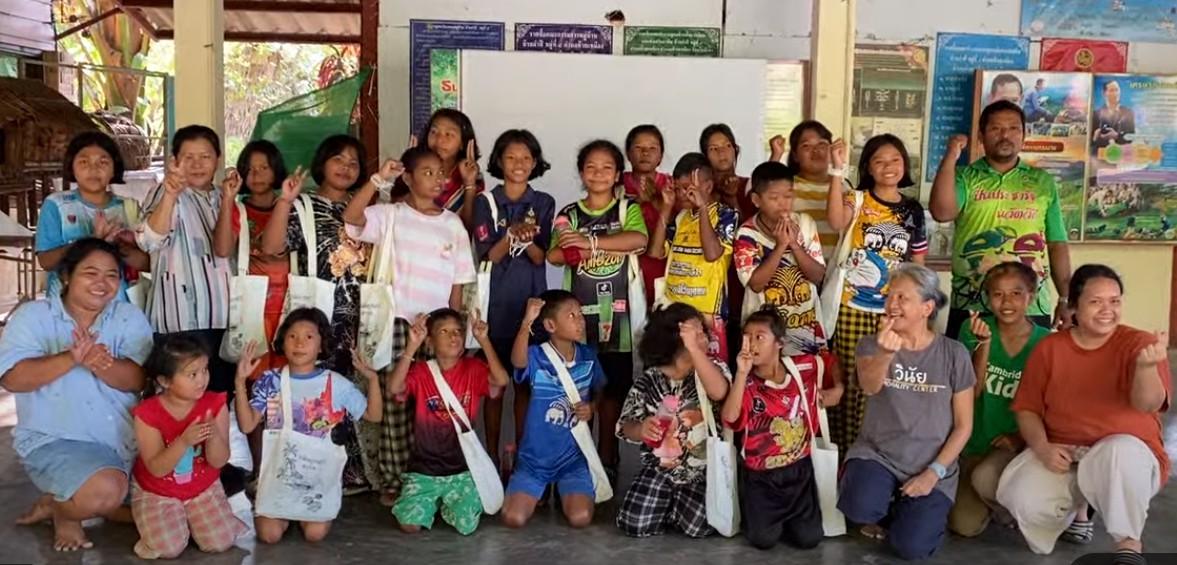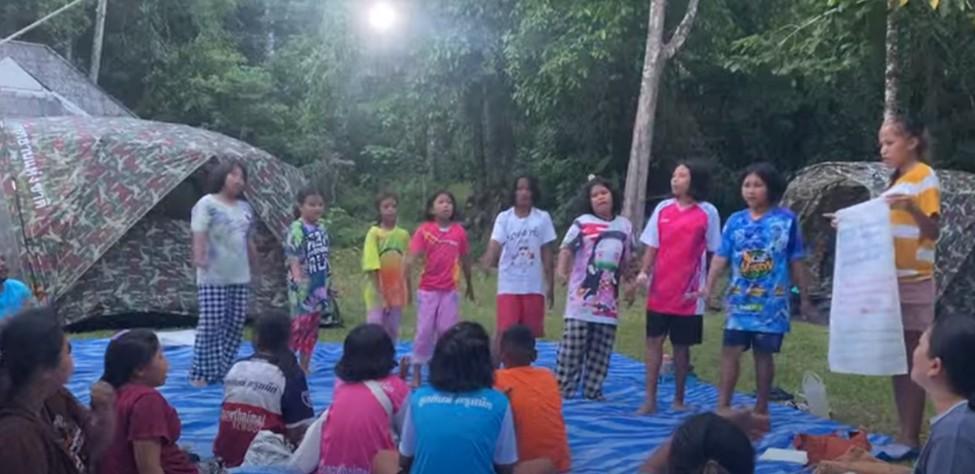One sunny morning in late 2004, the Moken people of the Surin Islands in the Andaman Sea witnessed an alarming phenomenon -- the seawaters suddenly receded even as the placid weather remained unchanged. For Moken elders, this was a harbinger of the Laboon, the furious god of the waves who is said to wreak devastation once every two generations. The entire community evacuated to higher ground.
Meanwhile, Moken seafarers who were taking tourists out snorkelling similarly noticed the ocean's unusual behaviour. They skilfully manoeuvred their boats away from the shoreline -- just as the massive tsunami struck. Their keen observation and well-honed instincts saved numerous lives in one of the deadliest natural disasters in recorded history.

Chao Lay communities work on the Field School project. Chulalongkorn University, Social Research Institute (Cusri)
Local insights for tackling global challenges
This account of the 2004 Indian Ocean earthquake and tsunami powerfully underscores the value of local knowledge acquired through direct interaction with the environment, and transmitted orally through legends that encapsulate accumulated multigenerational experience and intimate familiarity with local ecosystems.
Nevertheless, this body of knowledge has historically been overlooked. According to Narumon Arunotai, associate professor of anthropology at the Social Research Institute of Chulalongkorn University (Cusri), the Moken people, who are part of the ethnic group of former sea nomads known in Thailand as Chao Lay, were once commonly perceived as a burden on natural resources.
"But when we study their way of life, it turns out that Chao Lay communities have systems of thought, cultural practices and legends that allow them to use and nurture natural resources at the same time," says Narumon.
A growing body of international scholarship shows that such local knowledge can contribute to pressing challenges that threaten our planetary health today.

Montakarn Suvanatap Kittipaisalsilp, left, and Narumon Arunotai at Chulalongkorn University's Social Research Institute. Unesco
The NEA Initiative
In order to understand how nature can be leveraged for sustainable policy-making, Thailand is among the first Southeast Asian countries to undertake the National Ecosystem Assessment (NEA), alongside Cambodia and Vietnam. In partnership with Unesco and UNDP, this initiative has supported 14 countries so far in conducting assessments on biodiversity and ecosystem services and their interlinkages to people. The assessment harnesses multistakeholder engagement, linking science, policy and practice. Thailand is focusing its assessment on marine and coastal ecosystems, paying special attention to the role of indigenous and local knowledge.

Chao Lay communities work on the Field School project. Chulalongkorn University, Social Research Institute (Cusri)
Nexus of biodiversity and cultural diversity
Incorporating local knowledge into the National Ecosystem Assessment not only enhances our understanding of ecosystem services but also helps safeguard the contribution of local communities in natural resource management.
As Narumon remarks: "Biodiversity and the abundance of natural resources are sustained through our cultural diversity." For Chao Lay communities, coastal and marine ecosystems not only afford resources for daily sustenance but also hold tremendous significance through association with a wealth of local knowledge and cultural practices.
For instance, local Chao Lay knowledge is reflected in toponyms that reflect the rich history and legends associated with specific sites. For instance, the name Phi Phi is derived from "islands of giving", as one could shelter on the Phi Phi islands during a storm and expect a ready helping hand from the local community.
With advancing local development, however, many Chao Lay toponyms now merely evoke memories of bygone landmarks and waterways. The disappearance of local toponyms is part of a larger trend where other forms of indigenous and local knowledge are slowly disappearing, related to sustainable fisheries and other lifeways.

Chao Lay communities work on the Field School project. Chulalongkorn University, Social Research Institute (Cusri)
Empowering community-based research
In order to reverse the tide on the loss of indigenous and local knowledge, Unesco has been championing community-based research in many countries around the world, including Thailand.
"Community members should be the driving force in illuminating how their areas have profound social, economic and scientific value," remarks Montakarn Suvanatap Kittipaisalsilp, associate project officer for culture at the Unesco Regional Office in Bangkok.
Through a "Field School" initiative for capacity-building in safeguarding the living heritage of ethnic communities in Thailand, local ethnic groups from upland forested and Andaman coastal areas are learning tools for documenting local biodiversity and cultural practices related to ecological management with support from Unesco and the Princess Maha Chakri Sirindhorn Anthropology Centre (SAC).
This includes surveys on ethno-botany, natural resource use and indigenous know-how through the application of "7 Tools" for community mapping developed by the SAC, as well as Geographic Information System mapping using GPS and satellite imagery.
The aim is to leverage local insights in gathering and presenting data that can inform policy-making related to managing natural protected areas. Moreover, the activities provide a platform for intergenerational communication, whereby elders' wisdom for coexistence with nature can be imparted to ethnic youth.
"Nowadays, many young people are returning to their communities," remarks Sakunrat Yeesakun, a Cusri graduate student involved with the project. "Some of them aspire to become YouTubers so they can share stories of their communities."
Narumon stresses that the NEA and Field School initiatives are part of a long-term endeavour to "build capacity so that [ethnic communities] can participate in development and conservation efforts".
After all, inclusive development must be predicated upon an appreciation for the diversity of cultural values that inform our valuation of nature and ultimately guide national policies towards a sustainable future for all.
Chairat Chongvattanakij is a Thai-Canadian consultant specialising in content creation for the Communications and Public Engagement team at the Unesco Regional Office in Bangkok.



